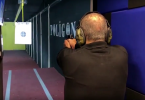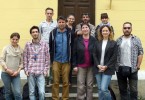A bloody Civil War took Greece under its grip just after the defeat of Nazi Germany in World War II. The hostilities between the governmental army supported by the USA and Britain and the Democratic Army of Greece (ELAS) continued until 1949 when the western powers and the Greek government were able to negotiate a peace settlement with the communists after Britain landed combat troops in the country.
Famous Greek director Photos Lambrinos found out by chance that a Turk took part inn the struggle on the side of ELAS and immediately decided to make a documentary about him. He was I said Mihri Belli, a well-known figure in Turkey’s political left.
“It was a casual information given to me by a friend in the beginning of 2007, in Komotini (Gumulcine). He was a Turk from Komotini, Sami Karabuyukoglu. He works at the state radio there. We became good friends and as we were talking about this and that, he asked whether I am aware of the existence of Mihri Belli, I said ‘no.’” Lambrinos explains how he came to know about Mihri Belli.
Karabuyukoglu, tells Lambrinos about Belli’s participation in the Greek Civil War on the side of the communists.
“It was a Tuesday and by Saturday, after I went to Athens and borrowed a camera from a friend, I was in his (Mihri Belli’s) home shooting the first pictures,” says Lambrinos.
They started talking in Greek and as they went on, says Lambrinos, Belli’s Greek became more fluent. He remembered the language he learned on the Rodopi mountains northeastern Greece.
Lambrinos says that he noted down the things Belli had to say about his life as a fighter. “From that initial material shot almost nothing was included in the film. I used that material to set up the scenario, it served as a preliminary work,” explains Lambrinos.
After returning to Athens from Istanbul, Lambrinos found a producer to finance his project.
“The producer, Costas Lambropoulos was enthusiastic about the subject, he took over the production, he gave me a crew, money and everything and I returned to Istanbul immediately. I found him (Mihri Belli), we did shootings at his house, in various parts of Istanbul and also the Four Seasons Hotel which was the prison (during the 19’/50s) where he had spent some time,” explains Lambrinos.
They also shot on the narrow street where Belli was critically wounded at an assassination attempt in 1979.
By train to revisit the battle grounds
After the shooting in Istanbul Lambrinos took Belli, then 92 years old, by a train to Western Thrace.
“We shot material in Alexandroupolis (Dedeagac) and also in Organi, a village up on the Rodopi mountains where he found some old partisans,” Lambrinos says.
“He found two partisans, one Greek and the other Turkish. They were much younger. The Greek was about ten years younger and the Turks was also ten years younger than him. At any rate in the partisan army of that period, the Democratic Army, most of the fighters were extremely young, sixteen years old, boys and girls, eighteen, twenty, twenty five. The instructors were a bit older,” Lambrinos explains.
Lots of Anatolian refugees in the ranks of ELAS
Many of the partisans fighting within the ranks of the communist army were Rums (Anatolian Greeks) who were subjected to exchange of populations between Turkey and Greece in 1923, so they spoke Turkish, Lambrinos says.
Mihri Belli was given the name Kapetan Kemal, (Kapetan was the term that referred to commanders of the partisans forces).
“Both Turkish speaking Muslims and Turkish speaking Pomaks but also many Greeks whose origins were from Mikra Asia (Anatolia) were speaking in Turkish to him until he started learning Greek, which he learned and spoke very well in the end,” says Lambrinos.
Contrary to the general belief, the Muslims of Western Thrace are not rigidly conservative. Many of the Muslims took part in the struggle on the side of ELAS.
“That is why he (Kapetan Kemal) started publishing a newspaper in Turkish called ‘Savas’ and he also prepared and published an alphabet book in Turkish. He also translated the ELAS anthem into Turkish and they all used to sing it together,” says Lambrinos.
Actually, in the documentary Mihri Belli remembers the ELAS march and sings it both in Greek and Turkish.
Kapetan Kemal also set up a 500-man partisan unit called the “Ottoman Regiment” consisting not only of Muslims but also Pomaks and Greeks, Lambrinos says.
Kapetan Kemal was needed on the mountains because of the existence of Muslim and Turkish-speaking elements in the ranks of the Democratic Army, explains Labrinos.
“Pomaks and Turkish origin people were living high up on the mountains, the remotest mountains were liberated first by the Democratic Army,” says Lambrinos.
“Kapetan Kemal” was received enthusiastically in Greece
Lambrinos says that “Kapetan Kemal” was first shown a month ago at the Salonica Film Festival and was received very enthusiastically by the audiences. In Athens too, the film was shown at a movie house for three days to a packed audience.
“The reactions were very positive. What I found interesting was that although Kemal makes some ‘stinging’ remarks about the Greek-Turkish war of 1919-1922, nobody reacted. Nobody told me, ‘How he can say such things!’ Because what he said was quite the opposite of the things that has been established as stereotypical in Greek history,” says Lambrinos about how his film was received by the audiences.
Newsreels as elements of historical documentaries
Lambrinos explains that he has been working with newsreels for the last 40 years and using them as elements for is documentaries.
“Newsreel is not something that we should accept as autonomous and undisputed evidence. We use that material to understand what actually happened, because they do not always tell the truth, or rather they almost never tell the truth. So we know what it shows but we have to handle it in a way in order to understand and comprehend what exists behind them,” says Lambrinos
“In other words, we use them for illustration not for documentation. There is a vast difference between the two,” he adds.
“Mihri Belli’s life resembles the life of my parents”
About Mihri Belli or as he calls him “Kapetan Kemal,” Lambrinos said, “I do not have special knowledge about his political course, his theory of revolution. I think, as he himself says, he is a Marxist revolutionary with whom you may agree or disagree. But what I consider as his greatest qualification is that he has a very high sense of humor and self sarcasm. I personally adore this. This was crucial for to get to love him very much. That was why during the screening I said that his life and his wife’s life resembles very much that of my mother and father,” said Lambrinos
Ariana Ferentinou






